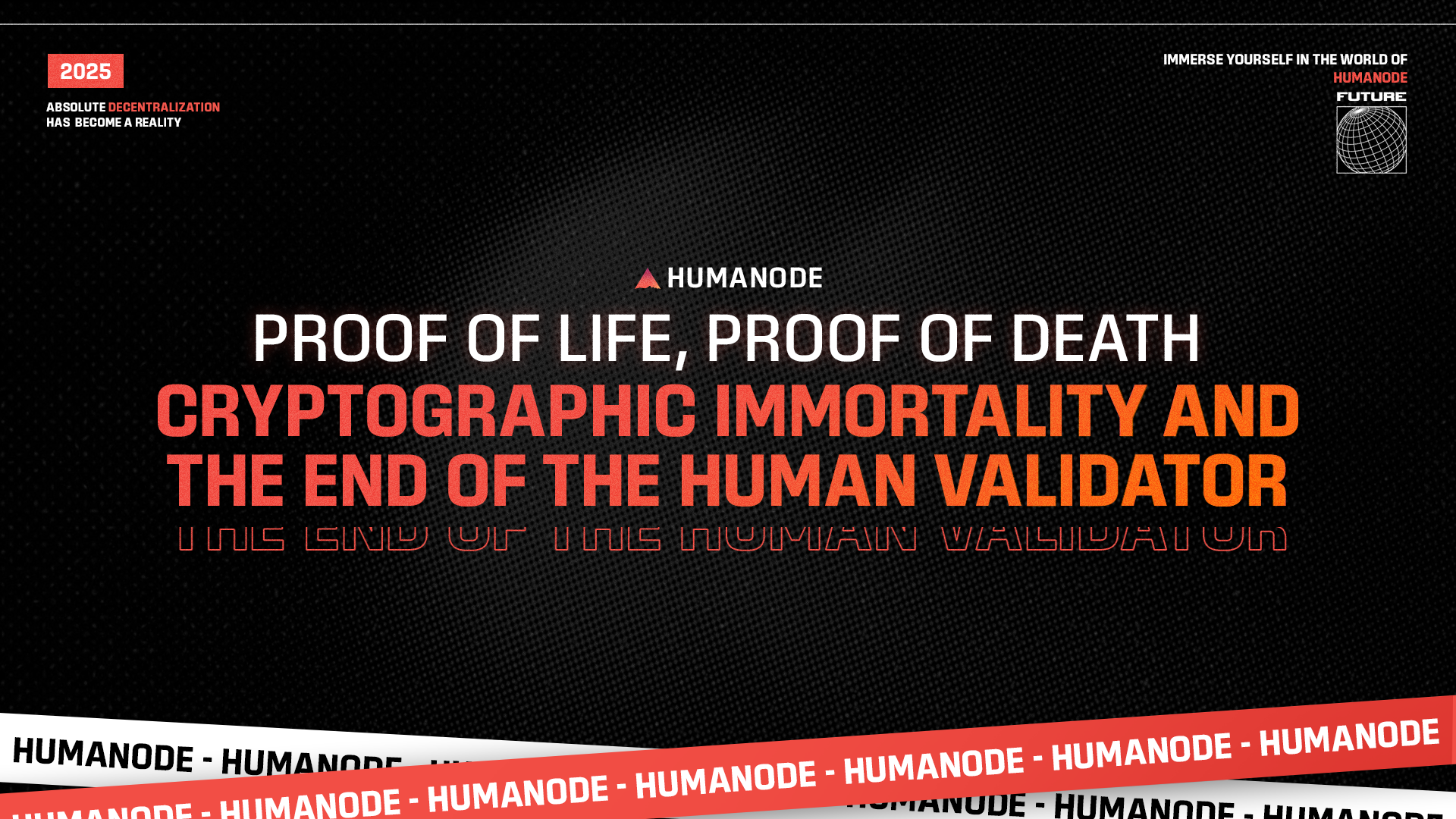Proof of Life, Proof of Death: Cryptographic Immortality and the End of the Human Validator

By Sasha Shilina
“The earth belongs…to the living; the dead have neither powers nor rights over it.”
— Thomas Jefferson, 1789
I. The Missing Death in Protocol Space
Blockchains are obsessed with beginnings.Genesis blocks. Fresh addresses. New epochs. “Go live.”
What they are not very good at is endings.
Private keys outlive the people who created them. Wallets become abandoned. Validators go dark. DAOs keep pinging addresses whose owners are already in the ground. The system sees only uptime and downtime, online and offline: never alive and dead.
Biometric-native projects like Humanode change this baseline. Suddenly, life itself is part of consensus design. A node is not just hardware with a key; it is a living, unique human, verified through liveness detection and bound cryptographically to their presence [1].
This isn’t just a philosophical twist but a practical one. If a network ties validation, voting power, or rewards to being alive right now, then it must also decide what happens when someone stops appearing. Power, assets, roles, and responsibilities cannot simply float forever. Death, disappearance, and long absence become part of protocol logic, not just off-chain tragedy.
As soon as you say, “to validate, you must be alive,” another question appears in the shadows: What happens when you are not?
In a world of “one person, one node,” death can no longer be treated as a mere “disconnect.” It becomes a protocol event.
II. Proof of Life as a Design Principle
Humanode’s cryptobiometric model rests on a strong intuition: Sybil resistance should come from personhood, not capital.
To participate, you must prove you are:
- Real: not a deepfake, not a bot.
- Unique: not one of many wallets spun by the same actor.
- Alive: passing a liveness check in real time.
In practice, this means:
- Your biometric template (stored privately and matched via secure computation) anchors your identity.
- Your role as a validator or participant depends on your capacity to periodically demonstrate living presence.
This is philosophically beautiful: consensus tied not to machines or money, but to the fact of being alive now.
Yet every proof of life silently implies a boundary, a frontier it cannot cross. Proof-of-life is meaningful because there is also un-life: absence, incapacity, death.
Blockchains normally ignore this boundary. Biometric chains cannot.
III. When Validators Die: The Necropolitics of a Liveness Network
In traditional crypto, if you die but your keys remain accessible, the network doesn’t care. Your economic and governance power persists so long as:
- The keys sign.
- The stake sits.
- The scripts run.
Here, death is an off-chain detail.
In a Humanode-style system, this is structurally impossible. If you are the validator, and the system requires your liveness, then:
- Your node must eventually fail the check.
- Your biometric cannot be replayed by others (in theory).
- Your validator slot is not just offline, it is vacated by mortality.
This raises uncomfortable questions:
- Who decides when a human is “gone enough” to be treated as dead?
- Do we rely purely on biometric failure (no more successful liveness checks), or can off-chain evidence matter (death certificates, witnesses, DAO rulings)?
- What happens to the rights you held: voting power, governance roles, revenue shares?
Here, the work of Achille Mbembe, a Cameroonian philosopher of power and postcolonial sovereignty, becomes strangely relevant. In his theory of necropolitics, Mbembe argues that modern power is defined not only by who it lets live, but by how it organizes exposure to death and non-existence [2]. In protocol space, necropolitics is not about killing people, but about how the system treats their remains:
- Dead accounts.
- Dead identities.
- Dead obligations.
Biometric validation makes this explicit: the human validator is finite; the ledger is not.
IV. Cryptographic Immortality vs. Mortal Validators
Crypto, by default, offers a strange kind of immortality:
- Keys can be stored for centuries.
- Data on-chain can persist as long as the network does.
- Smart contracts execute logic written by people who may already be dust.
In that sense, blockchains are machines of haunting: the gestures of the dead persist as executable instructions. Jacques Derrida, a French philosopher known for his idea of hauntology, insists that the present is always inhabited by the voices and effects of the dead — what he calls “specters.” [3]. On-chain, those specters are literal: multisigs signed by the long-gone, contracts nobody remembers deploying, long-dead founders whose decisions still structure entire ecosystems.
Biometric systems interrupt this illusion. They insist that:
- Signatures must be backed by living flesh.
- Validation must be re-earned by presence, not inherited by keys.
This creates a tension:
- On one side: cryptographic immortality — code, keys, contracts.
- On the other: biological finitude — bodies, breath, death.
A Humanode-like network lives exactly in this tension. It says: Your authority here comes from life, not from capital or legacy.
But then, how do we handle the moment when life stops and the ledger keeps going?
V. Designing for Death: Protocols That Know How to Let Go
If death is inevitable, it must become part of the design, not an awkward exception. A mature biometric blockchain needs, quite literally, a death protocol.
Some possibilities:
1. Time-Bound Personhood
Instead of assuming indefinite validity, biometric identities could:
- Require periodic liveness refreshes.
- Expire gracefully if no successful check occurs within a long window (months, years).
- Trigger an automated “validator sunset”, removing node rights, freezing certain roles, maybe converting economic rights into a different state.
Here, death is modelled probabilistically through sustained absence.
2. Cryptographic Wills and Inheritance
Certain rights (assets, shares in DAOs, intellectual property tokens) might:
- Be transferable through crypto wills: smart contracts that release access to designated heirs when liveness fails over a long interval or when specific proofs (legal docs, consensus decisions) are supplied.
- Distinguish between “voting rights” (non-inheritable, tied strictly to liveness) and “economic rights” (inheritable, linked to the estate).
In this view, validators die; ownership migrates.
3. Memorial vs. Deletion
Do we want to:
- Completely erase validators after death (identity tombstoning, anonymized)?
- Or preserve some trace, “memorial addresses” that record a life of participation without being usable?
This echoes the work of Philippe Ariès, a French historian of death, who showed how societies oscillate between more familiar, communal relationships to death and more privatized, hidden, medicalized ones [4]. On-chain, we are forced to decide: do we build a cemetery, an archive, or a shredder?
4. Governance Roles and Posthumous Power
Should the dead be able to:
- Continue influencing governance through previously cast long-term votes or locked-in delegation?
- Or should their influence fade as soon as liveness ceases?
One extreme: “no voice without life”, all political authority is strictly time-bound.Another: allow certain constitutions or charters signed by founders to remain, but ensure no ongoing dynamic control persists from the dead.
VI. The Ethics of Turning Death into a Condition
There’s a temptation to operationalize everything:
- Liveness: a threshold.
- Death: a timeout.
- Inheritance: a contract.
But the more precisely we encode death, the more we risk over-governing it.
Ethical questions:
- What about people in coma, severe illness, imprisonment, or forced disappearance? A long gap in liveness could mean death, or political violence, or disability, or fleeing a regime.
- What about people who choose to step away, to disappear from protocol life, a voluntary digital death that is not biological?
If death becomes a protocol condition, it must be designed with humility and graceful ambiguity. Some forms of “silence” should be reversible. Some accounts should be reclaimable after long absences with additional checks. Not every failure to appear should be treated as ontological finality.
In other words: Don’t let the chain declare you dead just because you went quiet.
VII. End of the Human Validator?
There is a darker horizon, too.
If AI agents one day pass liveness checks, or if we migrate to proofs of personhood that can be proxied or automated, we may see the gradual erosion of the human validator altogether.
- AI stewards maintaining keys in perpetuity.
- Synthetic entities granted “slots” in DAOs as non-human actors.
- Hybrid forms where humans become the initial seeds, then their “on-chain ghosts” live on as autonomous agents.
At that point, proof of life morphs into proof of origin: was there once a human somewhere at the root of this address?
The human-validator phase, like all stages of infrastructure, may itself be a waystation: between ungoverned pseudonymity and increasingly automated governance.
If so, our design choices now matter even more. They will define what traces we leave behind, and how future systems understand the difference between the living, the dead, and the never-alive.
VIII. Toward a Necrology for Protocols
Most projects write whitepapers and roadmaps, but almost no one writes a necrology, a theory of how users, roles, and rights should end.
Biometric blockchains like Humanode force this conversation:
- They tie validation to life.
- They refuse the fantasy that addresses and keys are neutral, timeless abstractions.
- They demand we ask: What do we owe the dead? What do we owe the living who must walk among their traces?
For Humanode and systems like it, this isn’t a philosophical luxury, but a necessary design space. Once life is a precondition of validation, death becomes a structural question: who should still have power, in what form, and for how long?
A humane liveness protocol would:
- Affirm that power and voice belong to the living.
- Allow wealth and recognition to move beyond them when they’re gone.
- Make room for disappearance, ambiguity, and return.
- Refuse to let long-dead keys rule the future.
In a sense, this is the ethical heart of proof-of-life: Not just that we can prove we are alive, but that we can build systems that know how to let us go.
Footnotes
- Humanode Core Team, Whitepaper v. 0.9.7 “Instrumentality of mankind” (2025). https://whitepaper.humanode.io
- Achille Mbembe, Necropolitics (Durham, NC: Duke University Press, 2019).
- Jacques Derrida, Specters of Marx: The State of the Debt, the Work of Mourning, and the New International (New York: Routledge, 1994); see also Archive Fever: A Freudian Impression (Chicago: University of Chicago Press, 1996).
- Philippe Ariès, Western Attitudes toward Death: From the Middle Ages to the Present (Baltimore: Johns Hopkins University Press, 1974); and The Hour of Our Death (New York: Knopf, 1981).

